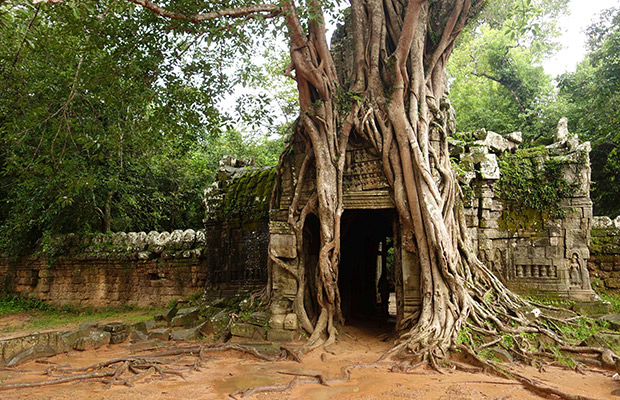
- Travel Name: Ta Som Temple
- Travel Destination: Siem Reap
Ta Som, which stands to the east of Preah Neak Poan, is one of the late-12th-century Buddhist temples of prolific builder Jayavarman VII. The most impressive feature at Ta Som is the huge tree completely overwhelming the eastern gopura, providing one of the most popular photo opportunities in the Angkor area.
Small, classic Bayon-style monastic complex consisting of a relatively flat enclosure, face tower gopuras and cruciform interior sanctuaries much like a miniature version of Ta Prohm. Many of the carvings are in good condition and display particularly fine execution for late 12th century works. Take note of the devata carvings which show an uncommon individuality. A huge tree grows from the top of the eastern gopura. It is destroying the gate but it is a photo classic. Best photographed in the afternoon. Ta Som is the most distant temple on the Grand Circuit.
Prasat Ta Som located in the east of Nean Pean. The entry and exit to Ta Som can only be access from east entrance. It was built in the end of the 12th century, dedicated to the father of the king (Buddhist), replica to Bayon style of art.
BACKGROUND
Ta Som has not been restored. It is a small quiet temple and affords a delightful visit.
In the past one of the significant features of Ta Som was the growth of fig trees the faces at the entrance towers. These have been cut from the east tower but they are still visible at the west one.
LAYOUT
Ta Som is a single tower monument on one level surrounded by three enclosing walls with entry on the east and west carved with four faces, the face on the right of the east tower (facing the temple) has a beautiful smile. The entry towers are in the shape of a cross with a small room on each side connecting to a laterite wall.
Walk through the first entry tower over a causeway, which crosses a moat and is bordered with serpents and large Garudas. The wall of the second enclosure is in laterite with a sandstone entry tower in the shape of a cross on the east and west sides. The entry towers have windows with balusters on the exterior and proceeded by a porch with pillars.
The next enclosure comprises a laterite and sandstone gallery with corner pavilions, which have molded false doors. Amongst the crumbled heaps of stones in the courtyard are two libraries opening to the west.
Structure
Designed to be entered from the east, Ta Som is surrounded by a moat and enclosed by three laterite walls which are broken by two sets of gopura (entrance ways). The gopuras are cross-shaped and contain a small room on each side along with windows containing balusters. The main structure of the gopura are carved with four faces in the Bayon style. The eastern outer gopura has been overgrown by a sacred fig (Ficus religiosa) which has grown down through the blocks that make up the gopura and into the ground. The inner section of the temple consists of a central cruciform sanctuary with porches at each arm surrounded by four corner pavilions. Two small libraries sit on either side of the eastern entrance path.
Restoration
According to the APSARA Authority who manage the temples in the Angkor Park, little restoration work had been done at Ta Som until the 1950s. At this time some propping of structures that were near collapse was carried out. After the WMF added Ta Som to their project, the WMF team began to document and interpret the site and carry out emergency stabilization of fragile structures and improvement to visitor flow around the monument.[4] In 2007, WMF and the APSARA Authority conducted clearing and documentation works that allowed the temple to be accessed from all four sides. Many sandstone blocks were repaired and this allowed the reconstruction of the North Central Fronton of the North Gopura.

Copyright © 2025, Cambo Tours & Travel - Discover Authentic Travel Experience, All Rights Reserved.